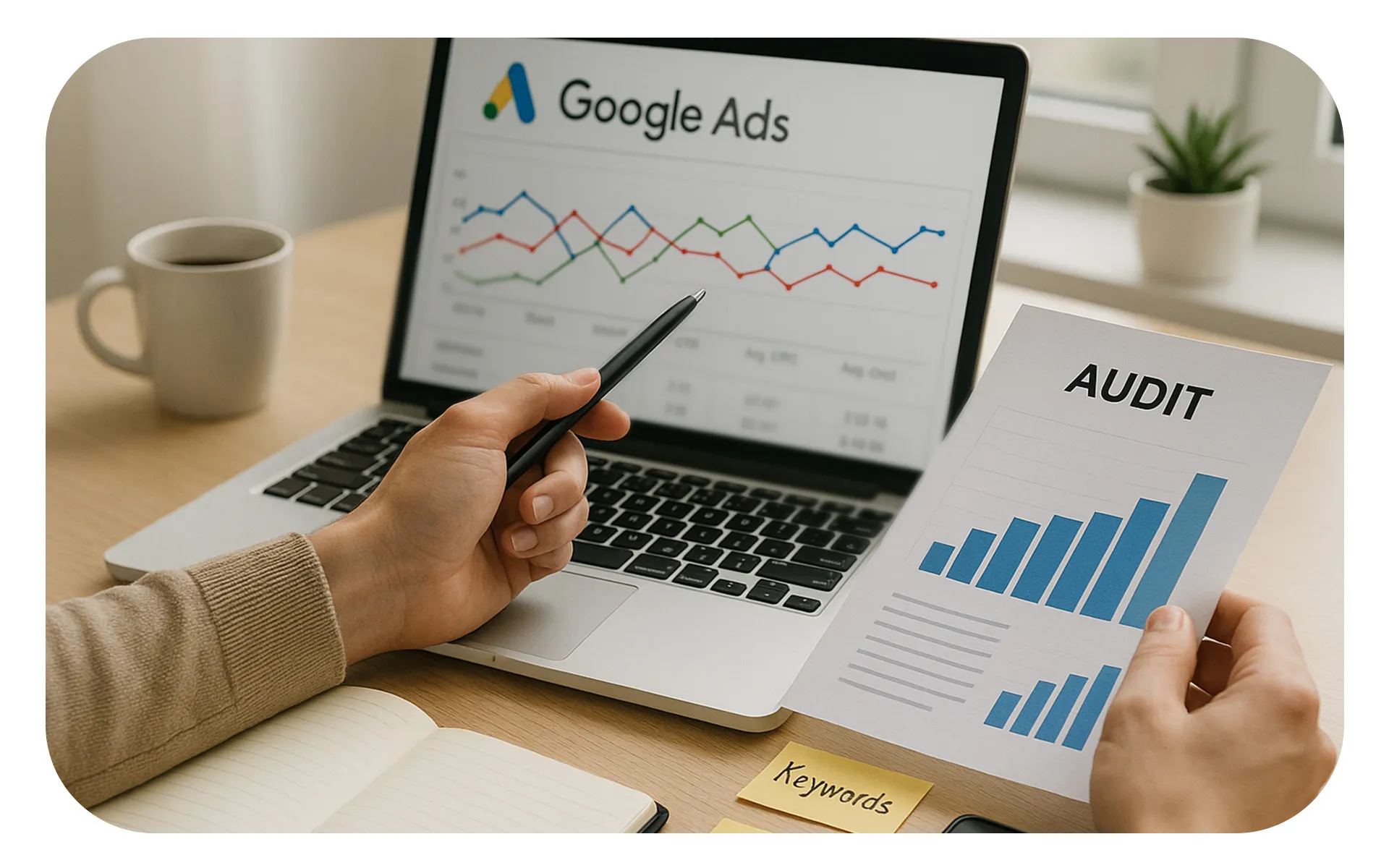read
As a business owner or manager, ensuring your Google Ads investment drives profitable sales is paramount. But navigating the platform's complexities to verify its effectiveness against your actual business goals can be daunting. A typical Google Ads audit might feel overly technical. This guide focuses on what truly impacts your bottom line, helping you understand if your ad spend is working effectively, identify potential issues even without deep technical knowledge, and ask the right questions of your team or agency. Conducting regular Google Ads audits this way becomes a strategic imperative, not just a technical check.
Google Ads Audit 2025: The Complete Guide for Ecommerce Brands
Based on extensive experience auditing Google Ads accounts, significant inefficiencies (often around 20%) are common. Addressing these through a focused PPC audit can lead to substantial savings or reinvestment opportunities. Let's explore ten key areas through a business lens to uncover potential improvements in your account. A comprehensive account audit like this provides crucial clarity.
We’ll cover:
Conversion Tracking
Content Suitability
Campaign Structure
Keywords & Ad Groups
Audience Targeting
Performance Trends
Product Performance
Bidding & Budgets
Landing Pages
Account Activity
This is a long article, so let's start with a quick reference table that can help you focus on areas where you think there could be a problem.

Quick Reference: Key Audit Areas and Business Impact
Performing a thorough Google Ads account audit involves looking at many interconnected parts. To help you quickly assess the health of your PPC campaigns and focus your advertising efforts, this table summarizes the key areas discussed, reframing them as core business goals. It highlights crucial positive indicators ("What Should Be Happening") and critical warning signs ("Red Flags to Look For") related to your key performance indicators and overall campaign performance. Use this as a quick reference during discussions with your team or agency about your paid search activities and Google Ads goals. Monitoring these key metrics is crucial for a successful Google Ads campaign.
Business Goal Focus | What Should Be Happening | Red Flags to Look For |
|---|---|---|
Ensure Accurate Sales Measurement | Only one primary purchase conversion action is active; Reported revenue in Ads closely matches actual store revenue. | Multiple primary purchase actions exist; Reported revenue drastically differs from actual sales (indicating double-counting or missed tracking). |
Maintain Brand Safety & Efficiency | Relevant content exclusions are applied (sensitive topics, irrelevant apps); Placement reports show mostly relevant sites. | No custom content exclusions in campaign settings; Significant spend occurs on irrelevant apps/sites or inappropriate content. |
Achieve Profitable Account Structure | Campaigns are clearly segmented (Brand vs. Non-Brand, product lines); Brand campaigns show significantly higher ROAS. | Generic campaign names hide strategy; Similar ROAS for Brand and Non-Brand campaigns suggests mixing of branded keywords. |
Attract Relevant Customer Searches | Ad groups are tightly themed at the appropriate ad group level; Search Terms report shows mostly relevant queries; Good ad relevance. | Generic ad groups exist with mixed keywords; High spend on irrelevant search terms; Negative keywords aren't regularly updated. |
Target Ideal Buyers Effectively | Clear remarketing strategy is active; Customer lists used for exclusion/targeting; Audience signals guide PMax (if used). | No remarketing is running; Customer lists aren't utilized; Audiences aren't informing PMax campaigns effectively. |
Interpret Performance Trends Accurately | Year-over-year comparisons used to account for seasonality; Attribution lag acknowledged in short-term analysis. | Decisions based solely on short-term data; Seasonality ignored in performance comparisons; Attribution lag dismissed. |
Maximize Profitable Product Sales | Ad spend aligns with product profitability (via shopping ads/PMax); Healthy Google Merchant Center feed status. | High spend on low-margin/poor-selling items; Major unresolved GMC feed disapprovals; Lack of product-level analysis. |
Optimize Bidding & Budget Allocation | Bidding strategies align with business goals (e.g., Target ROAS); Sufficient conversion data exists for automated bids. | Use of Max Clicks on broad campaigns; Automated bids used with insufficient conversion data; Frequent reactive bid changes. |
Convert Ad Traffic Effectively | Ads lead to relevant, fast-loading landing pages (especially for mobile campaigns); Page content matches ad message. | Ads link to homepage or irrelevant pages; Slow mobile page load speed; High bounce rates from key landing pages; Poor mobile traffic conversion. |
Ensure Consistent Account Management | Regular, varied optimization activity visible (bids, keywords, ads, ad assets, ad variations, ad rotation, ad scheduling); Changes are data-driven/strategic; Intelligent use of ad extensions. | Long periods of no activity; Only budget/bid adjustments made reactively; Frequent changes without allowing stabilization. |
If you're not a digital marketing expert or a PPC agency, you might not have a Google Ads audit tool. That's no problem. As we go through these concepts, we'll show you relevant questions to ask your team or agency about your active ads and your own campaigns.
1. Conversion Tracking: Are You Measuring Real Results?
Ensuring your Google Ads account accurately measures actual sales is fundamental to understanding profitability. Correct conversion tracking connects ad clicks to revenue, validating whether your ad spend generates a positive return. Without it, reported performance can be misleading, risking poor investment decisions. This involves setting up 'conversion actions' in Google Ads using tracking codes on your website, often managed via Google Tag Manager and potentially linked to your google analytics account, to record key events like purchases.
Here's what you want to see:
Only one primary conversion action actively counting your main e-commerce website purchases/transactions.
The total 'Conversion Value' (sales revenue) reported in Google Ads closely mirroring your actual store revenue over the same period (e.g., within 10-15%).
Use of Enhanced Conversions for potentially more accurate tracking in a privacy-conscious environment.
Micro-conversions like 'add-to-carts' designated as 'secondary' actions, not primary.
Here are signs of a problem:
Multiple 'purchase' or 'transaction' conversions listed as 'Primary' in the account settings.
Google Ads reporting significantly higher revenue (e.g., 50%+) than your actual store sales, indicating double-counting.
Google Ads reporting significantly lower revenue (e.g., 20%+) than actual sales, suggesting tracking is missing conversions.
Goals like 'page views' being used as the primary basis for purchase optimization.

Key Questions for Your Team/Agency
1. Can you show me which conversion action counts our main website purchases and confirm it's the only primary one?
2. How are we verifying that the revenue Google Ads reports aligns with our actual store sales figures?
3. Are we using Enhanced Conversions for more accurate tracking?
A Google Ads audit follow-up must always confirm tracking accuracy first.
2. Content Suitability: Is Your Brand Showing Up Safely and Efficiently?
Protecting your brand's reputation and maximizing budget efficiency are key business goals. You need to ensure your ads appear alongside appropriate content and avoid placements on irrelevant sites or apps where spend is wasted. This involves using Google Ads' "Content Suitability" settings to exclude certain websites, videos, app categories, and sensitive topics, particularly important for Display campaigns and Performance Max inventory.
Here's what you want to see:
Sensible content exclusions applied that align with your brand values (e.g., excluding tragedy, violence, excessive profanity).
Exclusion of typically low-value placements like irrelevant mobile app categories, parked domains, and potentially live stream videos.
Regular review of "Placement Reports" to identify and exclude specific underperforming or inappropriate websites, apps, or channels.
Minimal ad spend going towards placements that seem obviously irrelevant to your products or target audience.
Here are signs of a problem:
No specific content exclusions have been customized beyond Google's defaults.
Placement reports show significant budget spent on clearly irrelevant sources (e.g., children's game apps, foreign language sites).
Your ads are appearing on websites or YouTube channels that feel inappropriate or damaging to your brand image.
High spend on placements known for low visibility, like 'below the fold'.

Key Questions for Your Team/Agency
1. What specific content categories (like sensitive topics or app types) are we currently excluding?
2. Can we review a recent Placement Report to see where our budget is primarily going? Are we actively excluding poor placements?
Careful management here protects brand safety and reduces wasted ad spend.
3. Campaign Structure: Is Your Account Organized for Profit?
A logical structure for your Google Ads campaigns is essential for clear performance analysis, effective budget control, and ultimately, achieving profitability goals. Mixing different traffic types (like brand searches vs. generic searches) within the same campaign obscures true performance and hinders smart budget allocation. Key activities include naming campaigns clearly and segmenting them logically, notably separating campaigns targeting your specific brand name (branded keywords) from those targeting general product terms (Non-Brand), potentially with further splits by product category or campaign type (e.g., Performance Max, Standard Shopping).
Here's what you want to see:
Clear, descriptive campaign names indicating their purpose (e.g., Brand vs. Non-Brand, product category, location).
Distinct separation between Brand campaigns and Non-Brand campaigns.
Significantly higher ROAS (Return on Ad Spend) reported for Brand campaigns compared to Non-Brand campaigns.
Logical segmentation that aligns with your business structure (e.g., by product line or geographic region).
Here are signs of a problem:
Generic campaign names ("Campaign #1") that hide their strategic intent.
Inability to easily differentiate performance between Brand search traffic and Non-Brand search traffic.
Similar ROAS reported for Brand and Non-Brand campaigns (often means brand terms are mixed in Non-Brand, inflating its results).
Many campaigns with tiny budgets and negligible conversions cluttering the account.

Key Questions for Your Team/Agency
1. How are our campaigns separated between targeting our brand name versus generic product searches?
2. What's the performance difference (ROAS) between our Brand and Non-Brand campaigns over the last 90 days?
3. How are Performance Max campaigns structured regarding Brand vs. Non-Brand traffic?
A clean account structure is foundational for managing profitability effectively.
4. Keywords & Ad Groups: Are You Attracting the Right Customers?
Your keyword strategy directly impacts reaching customers actively searching for your products (driving growth) while avoiding spend on irrelevant searches (protecting profit). This involves selecting relevant keywords for search advertising campaigns, grouping them into tightly focused ad groups, writing corresponding ad copy, and using negative keywords to filter out unwanted traffic. Match types (exact match keywords, phrase match, broad match keywords) control how closely searches must align with your keywords.
Here's what you want to see:
Ad groups within Non-Brand search campaigns tightly themed around specific product types or variations.
The "Search Terms" report showing mostly relevant queries triggering your ads.
A regular process for reviewing the Search Terms report and adding new negative keywords to improve targeting.
Good ad relevance scores, indicating a strong match between keywords, ads, and landing pages.
Here are signs of a problem:
Ad groups contain a wide mix of unrelated keywords or have generic names like "Ad group1".
The Search Terms report shows significant spend on clearly irrelevant keywords or queries (e.g., competitor names you don't sell, features you don't offer).
Negative keyword lists haven't been updated in a long time, potentially allowing waste or blocking new relevant terms.
Ads show for searches explicitly requesting product attributes (size, color, format) that you do not offer. Be wary of duplicate keywords causing issues.

Key Questions for Your Team/Agency
1. Can you show me how keywords are grouped within one of our main Non-Brand campaigns? Are groups focused on specific products?
2. How often do you review the Search Terms report to find irrelevant searches and add negative keywords?
3. Do we have a strategy to avoid spending money on searches for product features we don't offer?
Targeting the right search intent improves Quality Score, Ad Rank, and overall campaign performance.
5. Audience Targeting: Are You Reaching Your Ideal Buyers?

Focusing your budget on users most likely to convert is key to achieving business goals efficiently. Google Ads allows targeting specific groups based on their demographics, interests, past website behavior (remarketing), or inclusion on your customer lists (Customer Match). Effective audience targeting improves conversion rates and ROAS by concentrating spend on your ideal target audience.
Relevant PPC activities include creating and applying these audience lists across various campaign types – Search, Display, and providing Audience Signals for Performance Max. Key tactics involve remarketing to past visitors and using Customer Match to exclude existing customers from new acquisition campaigns or target them with specific offers.
Here's what you want to see:
A clear remarketing strategy in place to re-engage users who visited your site but didn't purchase.
Use of Customer Match lists, particularly to exclude recent buyers from prospecting campaigns aimed at new customers.
Audiences being used effectively as signals to guide Performance Max campaigns (if applicable).
Audience lists showing healthy population sizes, indicating they are set up and tracking correctly.
Here are signs of a problem:
No active remarketing campaigns are running.
Your customer email lists are not being utilized in Google Ads (a major missed opportunity for efficiency).
Your team cannot clearly explain how audiences are informing Performance Max targeting.
Key audience lists show very small or zero members, suggesting a setup or tracking issue.

Key Questions for Your Team/Agency
1. What's our strategy for remarketing to people who visited our site but didn't buy?
2. Are we using our customer email lists to exclude recent buyers from our prospecting campaigns?
3. How are we using audience signals to help guide our Performance Max campaigns?
Reaching the right people efficiently boosts overall campaign effectiveness.
6. Performance Trend Analysis: Are You Looking at Results Correctly?
Making sound strategic decisions requires accurately interpreting performance trends over time. Reacting to short-term fluctuations or ignoring seasonal patterns can lead to poor choices that negatively impact your business goals. Analyzing performance involves selecting appropriate date ranges in Google Ads reports and making meaningful comparisons (e.g., month-over-month, year-over-year).
Here's what you want to see:
Performance analysis incorporates year-over-year comparisons to account for seasonality, especially in e-commerce.
Consideration for "attribution lag" – understanding that recent data might underreport final results due to delays between clicks and conversions.
Decisions based on trends observed over longer periods (e.g., 90+ days) rather than just the last few days or weeks.
Seasonal factors are explicitly discussed when comparing different time periods (e.g., Q1 vs Q4).
Here are signs of a problem:
Major strategic decisions frequently rely solely on very recent (last 7-30 days) performance data.
Performance comparisons consistently ignore seasonality, leading to misinterpretations (e.g., comparing January directly to December).
The team dismisses or doesn't account for the potential impact of attribution delay on recent conversion data.
Constant reactivity to minor performance dips without considering broader trends.

Key Questions for Your Team/Agency
1. When reviewing performance trends, how do we account for the delay between a click and a sale being reported?
2. How do we factor in seasonality when comparing performance? Are we primarily looking at year-over-year trends?
Accurate trend analysis prevents costly missteps and informs better strategic planning.

7. Product Performance: Are Your Ads Selling the Right Products Profitably?
For e-commerce, maximizing profitability means ensuring your ad budget effectively promotes products with good margins and sales velocity, while minimizing waste on underperformers. Analyzing performance at the individual product level within Shopping and Performance Max campaigns, managing the product feed in Google Merchant Center (GMC), and potentially structuring campaigns around product performance are crucial activities.
Here's what you want to see:
Ad spend generally correlates with product profitability and sales volume; high spend isn't wasted on low-margin or poor-selling items.
A healthy Google Merchant Center feed with minimal critical disapprovals affecting key products.
Evidence that performance is being analyzed at the individual product (SKU) level, not just campaign totals.
Strategies in place to address products receiving significant spend but generating few conversions.
Here are signs of a problem:
Significant ad budget allocated to products known to have low inventory, poor margins, or historically weak sales.
Persistent, unresolved issues with numerous product disapprovals in Google Merchant Center.
The team primarily discusses overall campaign metrics and seems unaware of specific product-level performance drivers.
Potentially good products seem to receive almost no visibility or spend within shopping campaigns.

Key Questions for Your Team/Agency
1. Can you show me which specific products get the most budget in Shopping/PMax? How is their sales performance?
2. Are there major issues with our Google Merchant Center product feed affecting key items?
3. How do we ensure ad spend isn't wasted on products that don't convert well or have low margins?
Granular product performance analysis is key to optimizing e-commerce ad spend.
8. Bidding & Budgets: Is Your Spending Strategy Smart?

Aligning your spending mechanisms with your business goals is critical. The bidding strategy tells Google how to spend your money in auctions, while budgets control the overall allocation. Using unsuitable strategies or insufficient data for automated bidding can lead to inefficient spend or missed opportunities for growth. Key activities involve selecting appropriate bidding strategies (e.g., Target ROAS, Maximize Conversion Value), setting budgets, and potentially using portfolio strategies.
Here's what you want to see:
Bidding strategies clearly aligned with primary business goals (e.g., Target ROAS for profitability focus).
Sufficient monthly conversion volume (often 30-50+) for campaigns relying heavily on automated bidding strategies.
Strategic budget allocation that prioritizes high-performing or high-potential campaigns.
A stable approach, avoiding constant, reactive changes to bidding strategies or targets.
Here are signs of a problem:
Using "Maximize Clicks" bidding for broad e-commerce campaigns without strong justification and controls.
Employing data-hungry automated strategies like Target ROAS on campaigns with very low conversion volume.
Frequent, rapid changes to bidding strategies or targets without allowing time for performance stabilization.
Budget allocation seems arbitrary or purely based on historical spend, not current performance.

Key Questions for Your Team/Agency
1. What main bidding strategies are used on our key campaigns, and how do they align with our business goals?
2. Are campaigns using automated bidding getting enough monthly conversions to work effectively?
3. How do we decide on budget allocation across campaigns?
Aligning bidding with goals and data is crucial for financial efficiency.
9. Landing Pages: Is Your Website Closing the Deal?
The user journey doesn't end with an ad click; the landing page experience is where conversions happen (or don't). A poor landing page—slow, confusing, or irrelevant to the ad—will waste even the best-targeted ad spend and hinder your goal of profitable sales. Optimizing this connection involves ensuring ads lead to relevant pages, the page content matches the ad promise, and the page itself offers a smooth user experience conducive to conversion.
Here's what you want to see:
Ads link directly to the most relevant specific product or category page possible.
Landing page content, offers, and visuals closely match the message of the preceding ad.
Key landing pages load quickly (ideally less than 3 seconds), especially on mobile devices.
A clear, intuitive path for the user to complete the desired action (e.g., Add to Cart, Purchase).
Here are signs of a problem:
Ads frequently direct users to the generic homepage instead of specific, relevant product/category pages.
The product or offer mentioned in the ad is difficult to find or different on the landing page.
Key landing pages suffer from noticeably slow load times, particularly on mobile.
The purchasing process from the landing page is confusing, lengthy, or frustrating.

Key Questions for Your Team/Agency
1. How do we ensure ads send traffic to the most relevant landing page?
2. Are we monitoring landing page metrics (like load speed, bounce rate, conversion rate) and making improvements?
3. How does our mobile landing page experience perform for ad traffic?
Your website's ability to convert visitors is a critical factor in Google Ads success.
10. Account Activity & Change History: Is Your Account Getting Proper Attention?
Google Ads requires ongoing, strategic management to maintain performance and adapt to changes. An account left on autopilot or managed only reactively will likely underperform against your business goals. Regular activities include reviewing data, adjusting bids/budgets, refining keywords/negatives, testing ads (managing different ad format options like Responsive Search Ads vs older expanded text ads), updating promotions, analyzing audiences, and making strategic adjustments based on results.
Here's what you want to see:
Evidence of regular, thoughtful optimization activity (e.g., weekly or bi-weekly adjustments).
Changes made across various areas over time (bids, keywords, ads, audiences, settings), not just budget tweaks.
Adjustments appear data-driven and aligned with strategic goals.
A proactive approach to testing and refinement.
Here are signs of a problem:
Extended periods (weeks/months) with no recorded changes in the account history.
The only changes are frequent, minor bid/budget adjustments without addressing underlying issues.
Constant, rapid changes to core settings (like bidding strategy) without allowing time for stabilization.
A lack of activity related to negative keywords, ad testing, or audience refinement.

Key Questions for Your Team/Agency
1. Can you summarize the main optimization activities undertaken in the account over the last month?
2. How often are key areas like search terms, ad performance, and placements reviewed for optimizations?
Consistent, strategic management is essential for maximizing your return from Google Ads.
Bringing It All Together: An Audit That Drives Business Value
Conducting a Google Ads audit through this business-focused framework transforms it into a valuable strategic review. By linking platform specifics back to your core business objectives, knowing where to look for key indicators, and asking targeted questions, you gain crucial visibility into your ad spend's effectiveness.
This understanding empowers you to have more productive conversations with your team or agency, spot potential issues early, and ensure your digital marketing investment truly drives profitable growth. Addressing inefficiencies found during regular Google Ads audits—even in just a few of these key areas—can significantly improve overall account performance.
While this guide provides the framework, deep diagnostics and implementing advanced solutions require dedicated expertise. If this review highlights areas of concern or uncertainty, professional assistance can be invaluable. At Optimum Click, we specialize in performing these thorough Google Ads audits for e-commerce brands, identifying concrete opportunities to enhance your ROAS and scale your business effectively.
Ready for clarity on your Google Ads performance? Click this link to request a free Google Ads audit. We provide expert analysis and actionable insights tailored to your account, helping ensure your Google Ads strategy is powerfully aligned with your business goals.


![AI Advertising in 2025: Real ROI vs Expensive Hype [Guide]](/_ipx/f_webp/img/blog/blog-ai-in-the-advertising-space.jpg)
